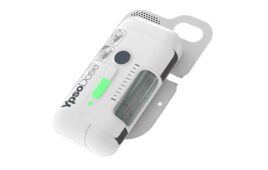
Copyright WuXi AppTec
Antibody-drug conjugates (ADCs) represent a significant paradigm shift in cancer treatment, marrying the precise target recognition of monoclonal antibodies with the potent cell-killing capabilities of cytotoxic agents. In contrast to traditional small-molecule therapies, ADCs are multifaceted structures with three distinct components — i.e., antibody, cytotoxic payload and a linker — each playing a crucial role in the drug’s operation and effectiveness.
Following administration, the antibody guides the payload to the tumor site, relying on the antibody’s ability to recognize and bind to cancer cell antigens. Once at the tumor site, the linker undergoes cleavage — through enzymatic action, changes in pH, exposure to light, iron or glutathione (GSH) or breakdown in lysosome — releasing the cytotoxic payload or payload-related metabolites to exert its lethal effect on the cancer cells.
Linkers can significantly influence an ADC’s pharmacokinetic properties and, therefore, must balance stability and release capability. Too stable, and the payload may not be released sufficiently to be effective; too unstable, and the payload might be released prematurely, causing off-target toxicities by impacting healthy cells.
The U.S. Food and Drug Administration (FDA) has approved 13 different ADCs, and more than 100 are in active clinical trials. While their value to cancer therapy is clear, ADCs are complex compounds. The design and choice of an ADC’s linker are critical to maximizing anti-tumor efficacy and minimizing off-target toxicity, thus warranting further exploration. Developing efficient linkers could be vital to improving the success of future ADCs and extending their use to a broader range of cancers.
ADC linker types
In the landscape of ADC development, several types of linkers have emerged. Each linker exhibits unique properties and offers distinct pros and cons.
- Acid-cleavable linkers: Acid-cleavable linkers are designed to undergo hydrolysis in the acidic environment found within cancer cells. However, these linkers have relatively poor plasma stability and a short half-life compared to other linkers. This instability can limit the type of cytotoxic payloads they can safely carry, as only moderately cytotoxic payloads should be connected owing to the risk of premature release in systemic circulation.
- GSH-cleavable linkers: GSH-cleavable linkers capitalize on the higher glutathione (GSH) concentrations found in cancer cells. These linkers are stable in the circulatory system, effectively delivering the cytotoxic payload to the tumor site without premature release. However, their stability can be influenced by α-substituents, potentially leading to variations in release profiles.
- Enzyme-cleavable linkers: Enzyme-cleavable linkers are designed to be cleaved by overexpressed enzymes in cancer cells. These linkers are typically represented by the prevalent MC-VC-PABC and MC-GGFG, which are more stable than GSH-cleavable and acid-cleavable ones, providing a solid balance between systemic stability and efficient payload release. They can effectively distinguish between plasma and target cells, reducing the risk of off-target toxicities.
Novel cleavable linkers
Scientists are developing several novel chemical linkers as well. These linkers are cleaved selectively in cancer cells, effectively sidestepping normal cells to minimize nontargeted tissue damage. For example, Fe (II)-cleavable linkers use iron as a trigger for cleavage; photo responsive cleavable linkers rely upon light wavelengths; and biorthogonal cleavable linkers are designed to avoid interference from native biochemical processes.
Non-cleavable linkers
Non-cleavable linkers are the most stable linker type. Unlike other types, these linkers do not break down under specific conditions within or around the tumor cell. Instead, the ADC must be internalized into the tumor cell and subjected to proteolytic degradation to release the cytotoxic payload. This type of ADC requires high antigen expression on tumor cells to ensure efficient internalization. While their enhanced stability in the bloodstream reduces the risk of off-target toxicities, the reliance on internalization and proteolysis may limit their effectiveness. Non-cleavable linkers are normally unable to exert “bystander effect.”
Harnessing the potential of ADCs requires careful consideration of the linker type, cytotoxic payload, tumor microenvironment and overexpressed antigen. This work requires expertise in biochemistry, pharmacology and analytical chemistry. As scientists’ understanding of ADCs evolves, so does their ability to customize and broaden ADCs’ use in other therapeutic scenarios. Drug developers and sponsors that do not have this expertise in-house should look to skilled lab testing partners for help.
Parameters for consideration in linker design
Designing an optimal linker is a critical aspect of ADC development and is both an art and a science. The goal is to develop a linker that complements the antibody and the cytotoxic payload but is also responsive to the target tumor cell environment, ensuring a balance between stability, specificity and efficacy. Conjugation site and chemistry, hydrophilicity, chemical trigger, linker length and steric hindrance all play roles in the linker’s design and contribute to its effectiveness.
The conjugation site, where the linker connects to the antibody, can impact ADC stability. The linker and payload must be solidly attached to prevent premature detachment and subsequent payload release. Similarly, the chemistry used for conjugation, including selecting functional groups to form the covalent bond, can also impact the compound’s stability and PK profile.
Detailed aspects of ADC linker design
A linker’s degree of hydrophilicity is another crucial consideration in ADC design. A linker with low hydrophilicity can drive the drug into different tissues, resulting in off-target toxicity. The balance, however, is in designing a linker with enough hydrophilicity to ensure the ADC maintains a sufficient half-life in circulation.
When a cleavable linker is used, the chemical trigger within the linker controls payload release in tumor cells. The more stable the trigger, the less likely premature payload release will occur. Triggers are usually designed to respond to specific conditions unique to the tumor microenvironment.
Linker length and steric hindrance also impact an ADC’s stability and functionality. A shorter linker may provide better stability by concealing the linker payload within the steric shield of the antibody. This reduces the payload’s exposure to enzymatic degradation and enhances its circulatory half-life. However, this must be balanced with the need for efficient payload release once at the target site.
The linker’s steric hindrance — i.e., a situation or component that prevents a reaction from occurring — can provide additional stability by hindering access to the payload-linker bond. However, excessive hindrance could affect the payload’s release. This delicate balance requires detailed structural analysis and rigorous testing to ensure optimal efficacy and safety.
Finally, cytotoxic drug choice is a crucial determinant in linker design. The payload’s potency, physicochemical properties and potential resistance influence a linker’s effectiveness and thus its design. Acid-cleavable linkers are relatively unstable and, therefore, not typically recommended for cytotoxic payloads. And while hydrophilic linkers can help overcome drug resistance, they may also impact an ADC’s PK profile and its efficacy. Matching a cytotoxic drug with a suitable linker requires an integrated and strategic approach to ADC development.
Current limitations and proposed solutions in linker design
ADC research is a rapidly advancing field with new developments continually emerging. The success or failure of an ADC hinges on the linker’s ability to remain stable in the bloodstream while ensuring effective release of the payload. A significant limitation in linker design is that existing linkers often release payloads non-specifically, leading to off-target toxicity. Three primary strategies may help overcome this challenge:
- Optimizing chemical triggers could help control payload release more precisely, leading to a reduction in off-target toxicity and an increase in therapeutic efficacy.
- Developing novel linker-antibody attachments could generate more stable and homogeneous ADCs, potentially improving their PK, efficacy, and safety profiles.
- Optimizing linkers to improve PK profile could involve strategic adjustments to hydrophilicity, chemical triggers and steric hindrance. A nuanced approach in these areas could positively impact PK profiles and reduce toxicity.
Another exciting development in the field is the concept of non-internalizing ADCs. Traditional ADCs rely on the internalization of the ADC into cancer cells to release their cytotoxic payload, requiring high expression of internalizing antigens on the tumor cells and efficient intracellular processing.
However, non-internalizing ADCs are designed to release payloads extracellularly from cleavable linkers upon reaching the tumor microenvironment. This allows the cytotoxic drug to kill cancer cells from the outside, potentially providing a more efficient therapeutic approach and widening the scope for ADC application in cancer treatment.
A final word on ADC and linker design
The ongoing research and advances in linker design are not only leading to the development of increasingly sophisticated ADCs but also offering new hope for improved cancer therapeutics. Exploring novel cleavable linkers and non-internalizing ADCs promises to push the boundaries of ADC technology, offering innovative solutions in cancer treatment.
Partnering with an experienced laboratory on ADC research and linker design can be invaluable. An experienced lab testing partner can provide technical expertise, sophisticated methodologies and regulatory familiarity. These insights can significantly accelerate the drug development timelines, improve the likelihood of clinical success, and ultimately provide effective cancer therapies to patients in need.
About Dr. Qigan Cheng
Dr. Qigan Cheng currently is a senior Study Director in DMPK Service Department of WuXi AppTec. He has more than 10 years of research experience in the field of drug discovery and development and more than 4 years of research experience in the field of preclinical pharmacokinetics. He has successfully supported more than 20 new drug IND applications globally.
Filed Under: Drug Delivery, Drug Discovery, Drug Discovery and Development, Oncology


